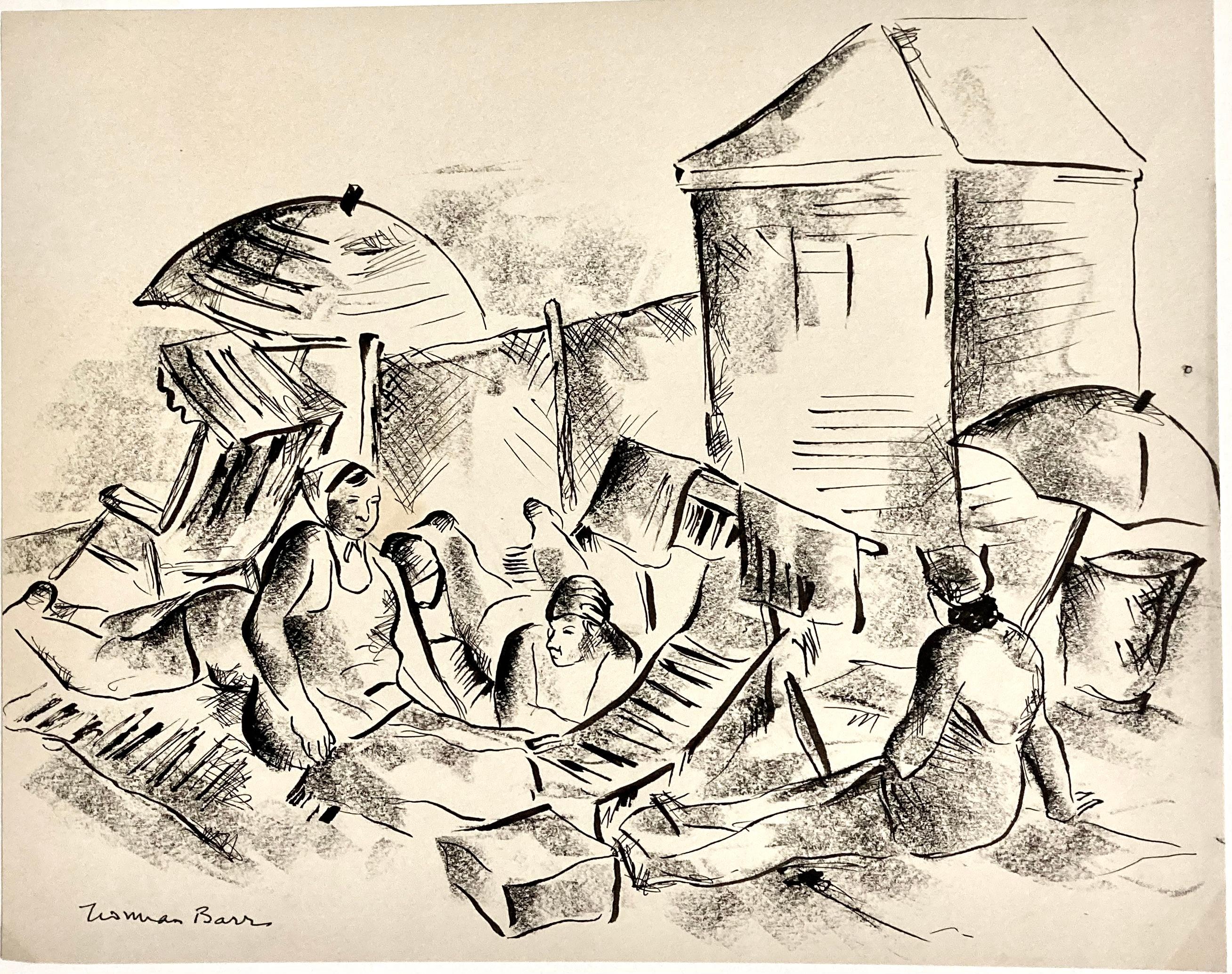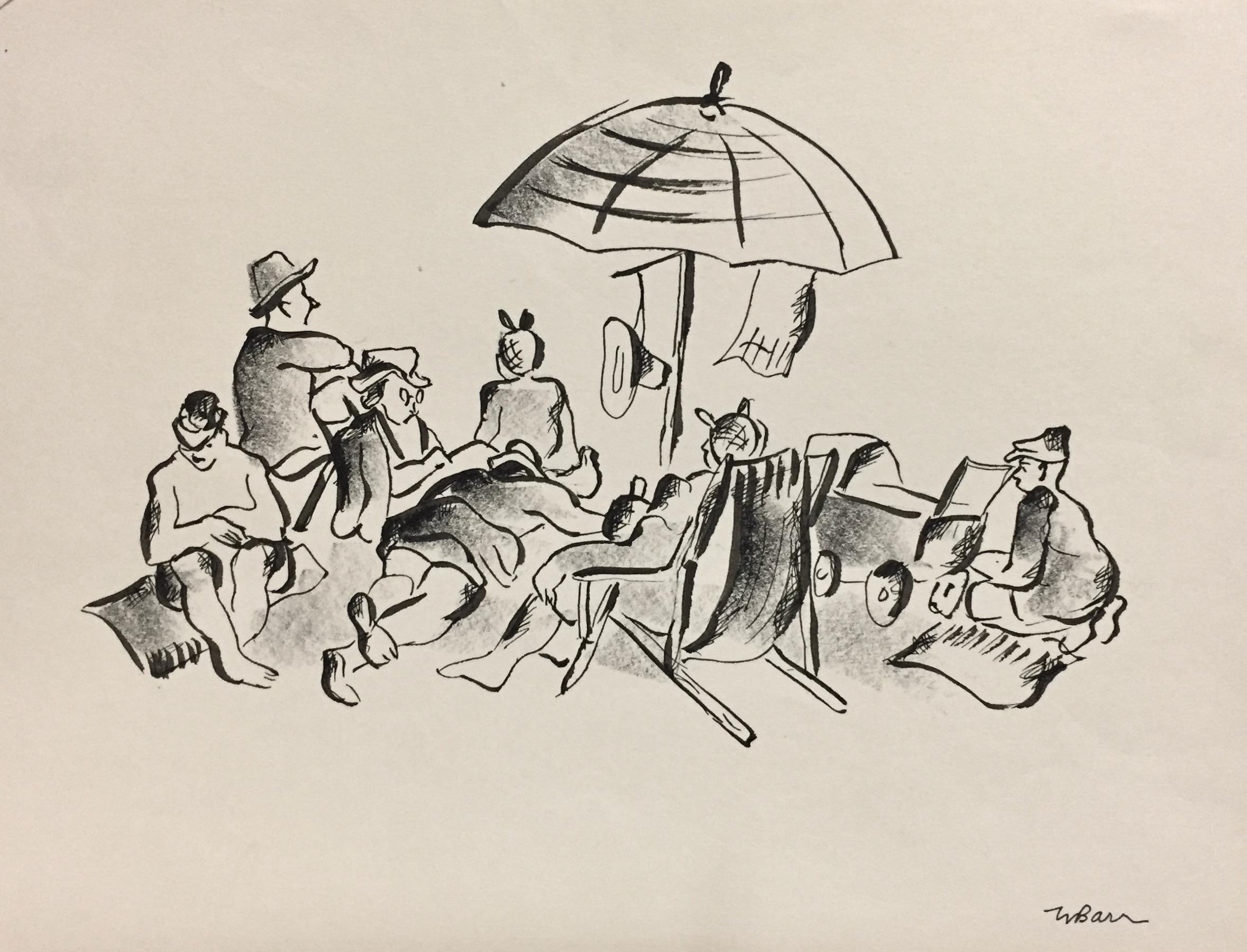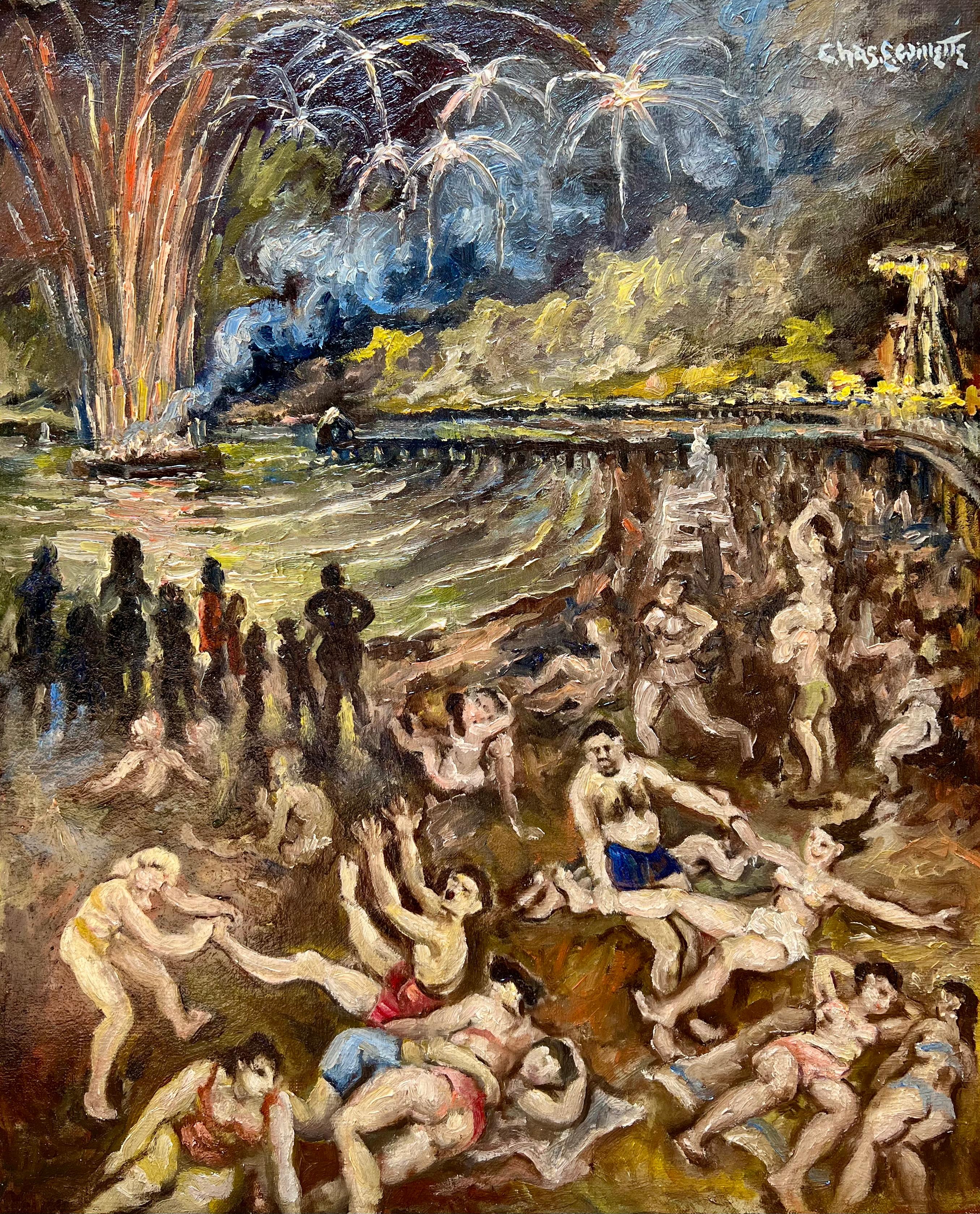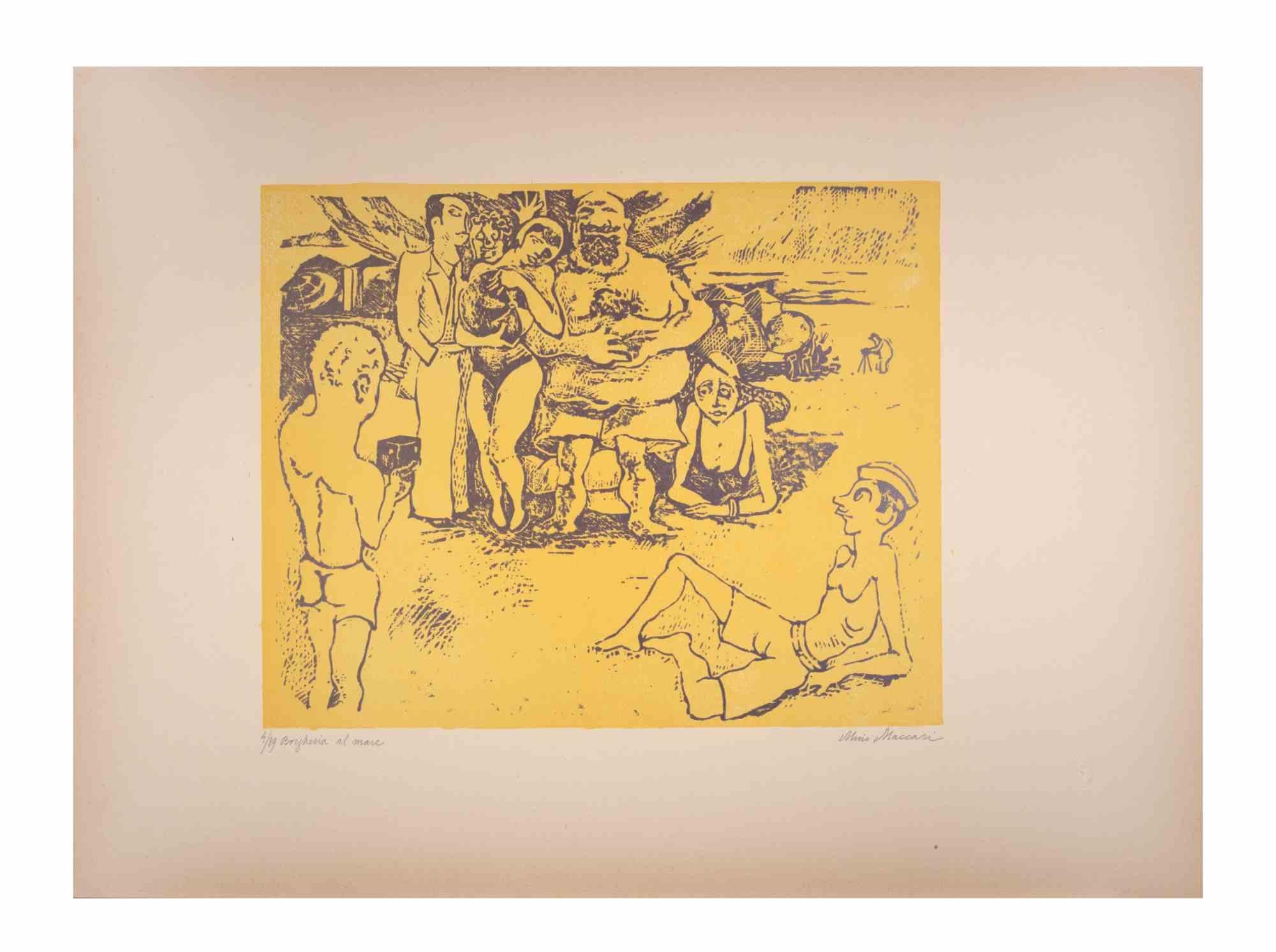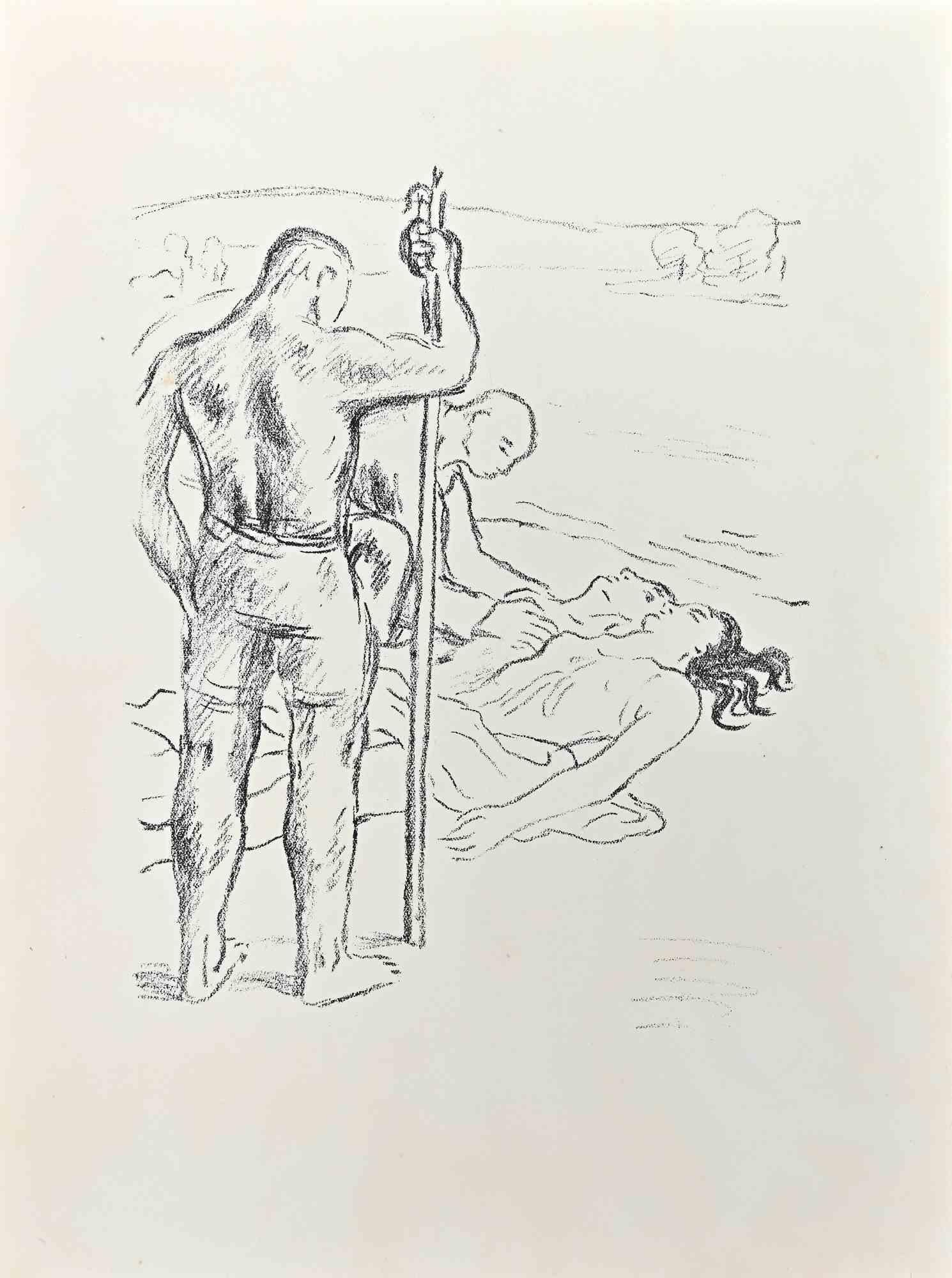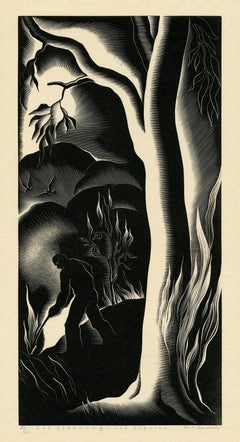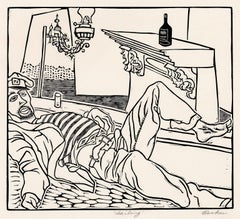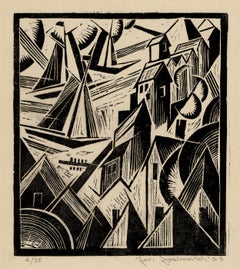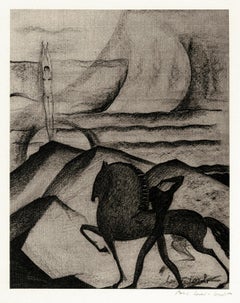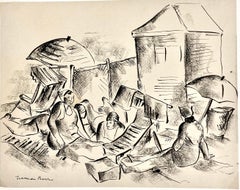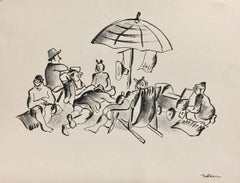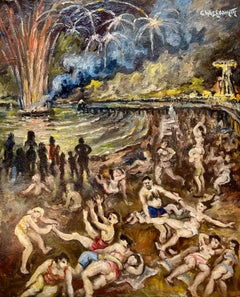Items Similar to On the Beach (Coney Island, New York) — 1930s Graphic Modernism, WPA
Want more images or videos?
Request additional images or videos from the seller
1 of 3
Lou BarlowOn the Beach (Coney Island, New York) — 1930s Graphic Modernism, WPAc. 1937
c. 1937
$1,700
£1,309.80
€1,496.20
CA$2,433.85
A$2,654.60
CHF 1,395.76
MX$31,856.37
NOK 17,623.04
SEK 16,437.49
DKK 11,174.44
About the Item
Lou Barlow (Louis Breslow), 'On the Beach' (Coney Island) wood engraving, c. 1937, edition c. 25. Signed and titled in pencil. Stamped 'FEDERAL ART PROJECT NYC WPA' in the bottom left margin. A fine, richly-inked impression, with all the fine lines printing clearly, on cream wove paper, with full margins (1 1/2 to 3 inches), in excellent condition. Matted to museum standards, unframed. Scarce.
Image size 11 x 8 1/8 inches; sheet size 16 x 11 3/8 inches.
Created during the Great Depression for the Works Progress Administration (WPA), Federal Art Project, New York City.
Impressions of this work are in the permanent collections of the Amon Carter Museum of Art, Illinois State Museum, and the New York Public Library.
ABOUT THE IMAGE
Due to Coney Island's proximity to Manhattan, Brooklyn, and other New York boroughs, it began attracting vacationers in the 1830s and 1840s. Most of the vacationers were wealthy and went by carriage roads and steamship services that reduced travel time from a formerly half-day journey to two hours. By the late 1870s, the development of Coney Island's amusement park attractions and hotels drew people from all social classes. When the Brooklyn Rapid Transit Company electrified the steam railroads and connected Brooklyn to Manhattan via the Brooklyn Bridge at the beginning of the 20th century, Coney Island turned rapidly from a resort to an accessible location for day-trippers seeking to escape the summer heat in New York City's tenements. In 1915, the Sea Beach Line was upgraded to a subway line, and the opening of the Stillwell Avenue station in 1919 ushered in Coney Island's busiest era. On the peak summer days, over a million people would travel to Coney Island. In 1937, New York City purchased a 400-foot-wide strip of land along the shoreline to allow the boardwalk to be moved 300 feet inland. At this point, Coney Island was so crowded on summer weekends that parks commissioner Robert Moses observed that a coffin would provide more space per person.
- Creator:
- Creation Year:c. 1937
- Dimensions:Height: 11 in (27.94 cm)Width: 8.18 in (20.78 cm)
- Medium:
- Movement & Style:
- Period:
- Condition:
- Gallery Location:Myrtle Beach, SC
- Reference Number:Seller: 1035231stDibs: LU53236097102
About the Seller
5.0
Recognized Seller
These prestigious sellers are industry leaders and represent the highest echelon for item quality and design.
Platinum Seller
Premium sellers with a 4.7+ rating and 24-hour response times
Established in 1995
1stDibs seller since 2016
333 sales on 1stDibs
Typical response time: 1 hour
Associations
International Fine Print Dealers Association
- ShippingRetrieving quote...Shipping from: Myrtle Beach, SC
- Return Policy
More From This Seller
View All'Lot Cleaning, Los Angeles' — 1930s Modernism
By Paul Landacre
Located in Myrtle Beach, SC
'Lot Cleaning, Los Angeles', wood engraving, edition 60, Zeitlin & Ver Brugge 69. Signed, titled and numbered '51/60' in pencil. A brilliant, black impression, on Kitakata Japan pape...
Category
1930s American Modern Figurative Prints
Materials
Woodcut
'Sailing' — Modernism, New York City WPA
Located in Myrtle Beach, SC
Fred Becker, 'Sailing', wood engraving, c. 1935, edition c. 25. Signed and titled in pencil. A fine, richly-inked impression, on off-white wove paper; with full margins (1 to 2 15/16...
Category
1930s Modern Figurative Prints
Materials
Woodcut
Harbor with Sailboats — Early 20th-Century Modernism
By George Josimovich
Located in Myrtle Beach, SC
George Josimovich, Untitled (Harbor with Sailboats) ', linocut, 1923, edition 35. Signed, dated, and annotated '4/35' in pencil. Initialed 'G J' in ...
Category
1920s American Modern Figurative Prints
Materials
Linocut
Rendez-Vous — Early 20th-Century Modernism
By Boris Lovet-Lorski
Located in Myrtle Beach, SC
Boris Lovet-Lorski, Untitled (Rendez-Vous), lithograph, edition 250, 1929. Signed in pencil. Signed in the stone, lower right. From a suite of 10 lithographs published by the artist ...
Category
1920s American Modern Nude Prints
Materials
Lithograph
'Modern Music' — WPA Modernism, New York City El
Located in Myrtle Beach, SC
Albert Potter, 'Modern Music' also Twilight Melodies', linocut, c. 1935, from the posthumous edition of 20, printed in 1977, authorized by the artist’s widow. Estate authenticated in...
Category
1930s American Modern Figurative Prints
Materials
Linocut
'Dancers' — 1930s American Modernism
By Charles Turzak
Located in Myrtle Beach, SC
Charles Turzak, 'Dancers', 1939, wood engraving, edition 100. Signed, titled, and numbered 72/100 in pencil. A fine, richly-inked impression, on off-white Japan paper, with full marg...
Category
Mid-20th Century Art Deco Figurative Prints
Materials
Woodcut
You May Also Like
Norman Barr, Coney Island (large), 1940
By Norman Barr
Located in New York, NY
Norman Barr recorded his beloved New York City from the Bronx, to Coney Island, to the Fulton Fish Market.
In this period he was on the New Deal's Mural ...
Category
Mid-20th Century Ashcan School Figurative Drawings and Watercolors
Materials
Crayon, India Ink
Norman Barr, Coney Island (New York City)
By Norman Barr
Located in New York, NY
An idyllic scene at New York City's favorite beach, Coney Island. Before the year was over Barr was in the Army.
It is ink and litho-crayon. Barr liked that medium because it didn't ...
Category
Mid-20th Century Ashcan School Figurative Drawings and Watercolors
Materials
Mixed Media
[Untitled] Beach Scene
By Harriet Keese Lanfair
Located in New York, NY
Harriet (Keese) Lanfair (1900-1988) lithograph, c. 1935, signed in pencil on lower right margin. Printed on a very light japan paper, with margins. A proof impression, with printers...
Category
1930s American Realist Figurative Prints
Materials
Lithograph
Coney Island, Fourth of July
Located in Los Angeles, CA
Coney Island, Fourth of July, c. 1940s, oil on canvas applied to Masonite, signed upper right, 26 x 21 1/2 inches, presented in its original frame
During the 1930s and 40s, Coney I...
Category
1940s American Modern Figurative Paintings
Materials
Board, Oil, Canvas
The Bourgeoisie at Sea - Woodcut by Mino Maccari - Mid-20th Century
By Mino Maccari
Located in Roma, IT
The bourgeoisie at sea is an Artwork realized by Mino Maccari (1924-1989) in the Mid-20th Century.
Colored woodcut on paper. Hand-signed on the lower, numbered 4/89 specimens and t...
Category
Mid-20th Century Modern Figurative Prints
Materials
Woodcut
Figures On Seaside - Lithograph by W. Gimmi - 1955 ca.
Located in Roma, IT
Figures On Seaside is a lithograph on ivory-colored paper realized by Wilhelm Gimmi in 1955 ca.
Very Good Conditions. Not signed, as issued.
The artwork is created in a realistic s...
Category
1950s Modern Figurative Prints
Materials
Lithograph
More Ways To Browse
Vintage Amusement
1930s New York
Barlow And Barlow
Nature Woodblock
Norman Hirst
Norman Rockwell Clock
Norman Rockwell Tom Sawyer
Nude Flask
Nude With Garter Dali
Odilon Redon On Sale
Oli Epp
Original Etching Roman Emperor
Ota Masamitsu
Oyvind Fahlstrom On Sale
Pablo Picasso Signed Aquatint
Pablo Picasso The Kiss
Parc Monceau Harold Altman
Pegge Hopper Print
